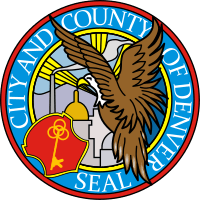Economy of Colorado
 Corn production in Colorado | |
| Statistics | |
|---|---|
| GDP | $306,663 million[1] |
GDP per capita | $48,730 [2] |
Population below poverty line | 13.7%[3] |
| 0.453[4] | |
Labor force | 2,819,800[5] |
| Unemployment | 3.0%[6] |
| Public finances | |
| Revenues | $8,586 million (2010)[7] |
| Expenses | $7,722 million[8] |
The economy of the US state of Colorado according to The Bureau of Economic Analysis gross state product estimates for 2008 was $248.6 billion.[9][10] The Colorado economy ranked 20th largest in the United States in 2008.[10] Per capita personal income in 2003 was $34,561, putting Colorado 8th in the nation.
The state's economy broadened from its mid-19th century roots in mining when irrigated agriculture developed, and by the late 19th century, raising livestock had become important. Early industry was based on the extraction and processing of minerals and agricultural products. Current agricultural products are cattle, wheat, marijuana, dairy products, corn, and hay.
In the second half of the 20th century, the industrial and service sectors have expanded greatly. The state's economy is diversified and is notable for its concentration of scientific research and high-technology industries. Other industries include food processing, transportation equipment, machinery, chemical products, minerals such as gold and molybdenum, and tourism. Denver is an important financial center.
Federal
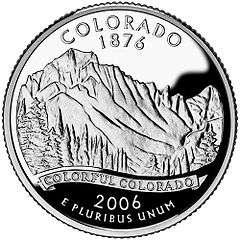
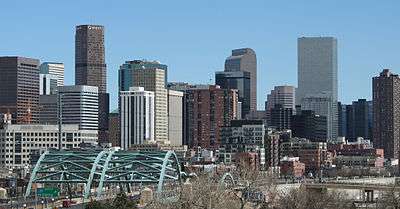
As of August 2013, Colorado had 53,800 nonmilitary federal employees, which made of 2.3 percent of the state’s total nonfarm employment, slightly above the national average of 2.0 percent. In addition, there were 37,285 active military in Colorado.[11]
Before Colorado was a state, it was a federal prison territory.[12] Today, the Federal Bureau of Prisons operates the Federal Correctional Complex, in Fremont County, which consists of several separate Federal prisons, including ADX Florence, the only supermax facility in the federal system, home to many convicted terrorists and other notorious criminals.
The North American Aerospace Defense Command (NORAD) and United States Air Force Academy are based in Colorado Springs; National Oceanic and Atmospheric Administration (NOAA), National Center for Atmospheric Research (NCAR) and the National Institute of Standards and Technology in Boulder; United States Geological Survey and other government agencies at the Denver Federal Center in Lakewood; the Denver Mint and United States Court of Appeals for the Tenth Circuit in Denver.
There is also a significant amount of federal lands in the state, including 11 National Forests and four National Parks. There are also numerous private companies that have operations in Colorado that deal with the governmental agencies in the state.
State taxes
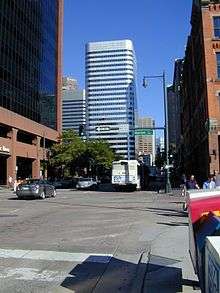
The Colorado income tax rate is a flat 4.63 percent of federal taxable income regardless of income level. Colorado's state sales tax is 2.9 percent on retail sales. Full-year Colorado residents can claim an excess sales tax refund on their individual state income tax return. Many counties and cities charge their own rates in addition to the base state rate. There are also certain county and special district taxes that may apply. The most common special district taxes are:
- Regional Transportation District (RTD), which affects the counties of Denver, Boulder, Jefferson and portions of Adams, Arapahoe, Broomfield and Douglas
- Cultural Facilities District (CD)
- Football Stadium District (FD or FTBL), approved by the voters to pay for and help build the Denver Broncos’ stadium
- Local Improvement District (LID) within designated areas of southeast Jefferson and Boulder counties
- Regional Transportation District (RTA) taxes at varying rates in Basalt, Carbondale, Glenwood Springs, Gunnison County
Real estate and personal business property are taxable in Colorado. The state's senior property tax exemption was temporarily suspended by the Colorado Legislature in 2003. The tax break is scheduled to return for assessment year 2006, payable in 2007.
Denver's economy
Denver's economy (Denver is the Rocky Mountain region's most populous city), is based largely on its geographic position. The Denver metropolitan area is the largest in the area (the nearest metro area of comparable size is the Kansas City Metropolitan Area about 600 miles east). Denver is the location of federal, high-tech, educational, commercial, financial, cultural, tourist, storage, and distribution services to the Rocky Mountain States. The city is also home to several large corporations in the central United States.
Geography and trade
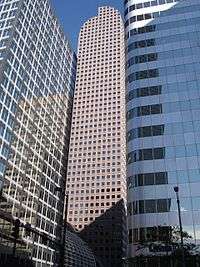
Many federal agencies are based or have offices in the Denver area. In addition to federal agencies, there are many companies based on federal defense and space projects. Lockheed-Martin and Ball Aerospace & Technologies Corp. are examples. Being the capital of the state of Colorado also gives many state jobs to Denver.
Denver's position as the largest city in a mineral-rich and fossil fuel-rich area leads mining and energy companies to maintain offices in the metro area. In the early days of the city, gold and silver booms and busts played a large role in the economic success of the city. In the 1970s and early 1980s, the energy crisis in America created an energy boom in Denver captured in the soap opera Dynasty. Downtown Denver was built up considerably during this time; many new downtown skyscrapers were built. Eventually the oil prices dropped from $34 a barrel in 1981 to $9 a barrel in 1986, and the Denver economy dropped with it, leaving almost 15,000 oil industry workers in the area unemployed (including mayor John Hickenlooper, a former geologist), and the highest office vacancy rate in the nation (30%).[13] Energy and mining are still important in Denver's economy today, with companies such as Newmont Mining, Patina Oil and Gas, and Western Gas Resources.
Denver's west-central geographic location in the Mountain Time Zone (UTC −7) also benefits the telecommunications industry by allowing communication with both North American coasts, South America, Europe, and Asia in the same business day. Denver's location on the 105th meridian west at over 1 mile in elevation also enables it to be the largest city in the U.S. to offer a 'one-bounce' real-time satellite uplink to six continents in the same business day. Qwest Communications, EchoStar, Starz-Encore, and Comcast are just a few of the telecommunications companies with operations in the Denver area. These and other high-tech companies had a boom in Denver in the mid to late 1990s, but the technology bust in the new millennium caused Denver to lose many of those technology jobs. Recently the Denver area has started making a comeback, with the October 2005 unemployment at 4.7% the lowest since September 2001.[14] Denver government and industry leaders are attempting to diversify the Denver economy so that it is less susceptible to boom and bust cycles.
Agriculture
Colorado has a large agricultural market. Colorado's ranchers and farmers receive average payments per year totaling $316 million from the federal government including wheat subsidies averaging $79 million a year, corn subsidies averaging $78 million a year, total conservation-reserve acreage payments of $75 million, livestock and dairy subsidies of $10 million, and disaster payments totaling $47 million.[15]
See also
- Colorado Companies
- List of companies with Denver area operations
References
- ↑ http://research.stlouisfed.org/fred2/graph/?id=CONGSP
- ↑ http://research.stlouisfed.org/fred2/graph/?id=COPCPI
- ↑ http://www.census.gov/compendia/statab/2011/ranks/rank34.html
- ↑ http://factfinder.census.gov/servlet/DTTable?_bm=y&-context=dt&-ds_name=ACS_2009_1YR_G00_&-_geoSkip=0&-CONTEXT=dt&-mt_name=ACS_2009_1YR_G2000_B19083&-tree_id=307&-_skip=0&-redoLog=false&-geo_id=04000US01&-geo_id=04000US02&-geo_id=04000US04&-geo_id=04000US05&-geo_id=04000US06&-geo_id=04000US08&-geo_id=04000US09&-geo_id=04000US10&-geo_id=04000US11&-geo_id=04000US12&-geo_id=04000US13&-geo_id=04000US15&-geo_id=04000US16&-geo_id=04000US17&-geo_id=04000US18&-geo_id=04000US19&-geo_id=04000US20&-geo_id=04000US21&-geo_id=04000US22&-geo_id=04000US23&-geo_id=04000US24&-geo_id=04000US25&-geo_id=04000US26&-geo_id=04000US27&-geo_id=04000US28&-geo_id=04000US29&-geo_id=04000US30&-geo_id=04000US31&-geo_id=04000US32&-geo_id=04000US33&-geo_id=04000US34&-geo_id=04000US35&-geo_id=04000US36&-geo_id=04000US37&-geo_id=04000US38&-geo_id=04000US39&-geo_id=04000US40&-geo_id=04000US41&-geo_id=04000US42&-geo_id=04000US44&-geo_id=04000US45&-geo_id=04000US46&-geo_id=04000US47&-geo_id=04000US48&-geo_id=04000US49&-geo_id=04000US50&-geo_id=04000US51&-geo_id=04000US53&-geo_id=04000US54&-geo_id=04000US55&-geo_id=04000US56&-geo_id=04000US72&-search_results=01000US&4-_showChild=Y&-format=&-_lang=en&-_toggle=
- ↑ http://research.stlouisfed.org/fred2/data/COLFN.txt
- ↑ http://www.bls.gov/eag/eag.co.htm
- ↑ http://www.census.gov/govs/statetax/1006costax.html
- ↑ http://nasbo.org/LinkClick.aspx?fileticket=w7RqO74llEw%3d&tabid=79[]
- ↑ "Gross Domestic Product (GDP) by State" (Press release). Bureau of Economic Analysis. 2009-06-02. Retrieved 2010-04-20.
- 1 2 "Colorado economic output GDP". EconPost.com. January 20, 2010. Retrieved April 20, 2010.
- ↑ Federal employees by state, Governing Magazine, accessed 29 March 2016.
- ↑ http://www.jstor.org/stable/40168971?seq=1#page_scan_tab_contents
- ↑ Denver History – Short History
- ↑ Metro Denver Business Economy & Economic Summary Archive
- ↑ "GOP-leaning farmers may face tough choice in Senate race" article by Michael Booth in The Denver Post 10/11/2010, accessed October 11, 2010

